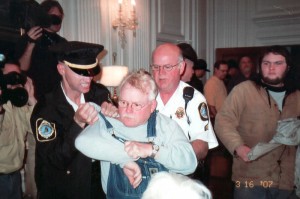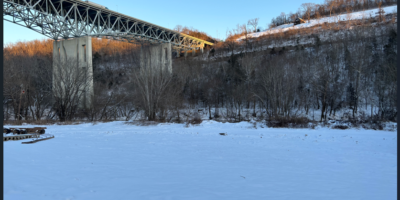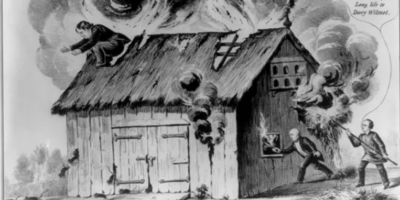Remembering Larry Gibson
By Dave Cooper
An American hero has passed away. Larry Gibson, the “Mountain Keeper” from West Virginia who fought for over 25 years to save his family’s ancestral land on top of Kayford Mountain, died on his beloved mountain of a heart attack on Sunday, September 9.

Larry Gibson being arrested as part of a non-violent demonstration against mountaintop removal in West Virginia Governor Joe Manchin’s office, March 2007. Photo by Dave Cooper.
Larry fought the good fight. One of the first West Virginians to try and organize people against mountaintop removal (MTR), he fought longer and harder against that destructive process of coal extraction than anyone else ever could. Beginning as a volunteer with the West Virginia Citizen Action Group (WV-CAG) in the mid-1980s, Larry soon joined the Ohio Valley Environmental Coalition (OVEC) and, with the help of OVEC organizer Laura Forman, began speaking publicly against MTR by the late 1990s.
When I first met Larry in March, 1998, I wasn’t too sure what to think of him. He was not a polished speaker and it was sometimes difficult to understand what he was saying. But like me, he was a former General Motors employee, and he had a lot of good GM stories from his days on the assembly line in Lordstown, Ohio, so we hit it off.
Meeting Larry changed my life. Shortly after hearing him speak, I visited Kayford Mountain, and 14 years later I’m still working on the mountaintop removal issue.
He changed many other lives, too, and over the long run he may have done more than any other individual to build the anti-MTR movement. You see, I was not alone in my visit to Kayford Mountain; Larry invited everyone who heard him speak to visit there. Always generous with his time, he treated all who came to visit his mountain equally, whether it was a group of 10 students from a local high school or Mike Wallace of 60 Minutes. Partially as a result, his home place became the birthplace of the movement against mountaintop removal. Some people said Larry reminded them of “The Lorax” from the Dr. Suess book, and I think they are right—the Lorax spoke for the trees, while Larry spoke for the mountains. (Both also had that same little white moustache.)
A constant presence at rallies, meetings and gatherings across the world, Larry developed into an important public figure in the fight to stop coal companies from destroying the land they worked. In 1999, he walked across West Virginia with Julian Martin of the West Virginia Highlands Conservancy to bring greater attention to the MTR issue. The same year he was featured in an excellent Nightline episode, “Digging Deep: The Cost of Cheap Energy,” one of what would become many featured spots in the growing archive of cinematic and print journalism looking at the travesty of mountaintop removal. In the Nightline episode, he guided ABC’s Barry Serafin around his Kayford Mountain home and the nearby ravages of a mountaintop removal site. “I don’t care if it’s a coal company, oil company or chemical company,” he told Serafin on camera, “I’ll go anywhere and talk against the destruction of what’s happening here. I’ll go anywhere.”
By the time of his death, Gibson’s travel anywhere approach to talk about his mountain and the ravages of mountaintop removal included time spent in protests, such as the Washington D.C. “Appalachia Rising” protests of 2010, and speaking at countless gatherings and meetings in places ranging from San Francisco to New Guinea, from numerous Appalachian coal communities to South American mining towns.
As a speaker and developing community leader, Larry owed a lot to his mentor Ken Hechler, the legendary former Congressman and West Virginia Secretary of State who has been a lifelong crusader against strip mining abuses. The only member of Congress who marched with Dr. Martin Luther King while in office, Ken taught Larry lessons from the Civil Rights struggle about the importance of non-violence in the campaign against mountaintop removal. Ken’s mentoring helped push Larry to channel his thoughts and righteous anger, and to place his struggle within larger systems of oppression. When we toured together on the Mountaintop Removal Road Show, he would always ask his audience:
“What do you have in your own circle of life that is so precious that you cannot put a price on it? What would it be? And if someone tried to come and take it from you, what would you do –how far would you go to stand for it? For me, it was my land. For me, it was my mountain.”
This personal connection Larry felt for his land, an intimacy that compelled him to act, was always at the heart of his activism. As he asked Serafin in the 1999 episode of Nightline, “How can you do this to your own back yard? Where you gonna play? I used to play here.” The mountains for him were not abstract containers of mineral wealth needing to be tapped. They were home.
I recall a scene from Nashville filmmaker Jeff Barrie’s film Kilowatt Ours. While offering Jeff a tour of his family cemetery on Kayford, a blast suddenly goes off on the nearby mine site. Hurrying to the edge of the mountain as Jeff’s camera catches the huge cloud of dust rising above the moonscape, Larry ponders his situation. “People, a lot of people ask me if I have a picture of the mountain before it was destroyed. For one, you can’t take a picture of a mountain while you’re on it, but for two, Lord have mercy, why should you take a picture of a mountain? It’s gonna be there forever. At least I thought …”
Heroes
Right now, Larry is happily roaming the green, unscarred mountains of the West Virginia of his youth—”the mountains with no boundaries, no limits,” as he described them in the 2007 documentary Mountaintop Removal. He, at least, is in a better place. But what should we the living do now?
This is an incredibly important struggle. Burning coal is at the heart of the climate crisis; those who study global warming make unsettling predictions. If some of these experts are right, we are fast approaching a “tipping point” beyond which rising global temperatures cannot be reversed, no matter what we do. The earth will just keep warming and warming.
Who are the people trying to stop the destruction of the very life support systems keeping us all alive? There aren’t very many of them, and even fewer are actually willing to put their own life and safety on the line. Larry was one of those people. He was fearless and he was tireless. If the human race is able to survive runaway global climate change, there will one day be statues and monuments to heroes of the planet like Larry Gibson.
Judy Bonds, Laura Forman and Ken Hechler will have giant statues erected in their honored memory. James Hansen, Bill McKibben and Harry Caudill will have great bronze plaques detailing their struggles to stop the worst ravages of coal. They will all be in the history books, and future students will read about them and wonder why more average people did not try and help stop mountaintop removal and runaway climate change. They will look at the photos of RAMPS and Mountain Justice activists being arrested for non-violent civil disobedience with the same sense of wonder and disbelief that we feel today when we see photos of civil rights protestors being attacked by Sheriff Bull Connor’s dogs. They will wonder, how could so many people have stood by and let the mountains be destroyed?
We need more Mountain Keepers like Larry—do you dare to be one, too? Will you join the movement?
Friends and family of Larry Gibson, the “Keeper of the Mountains,” will celebrate his life and legacy on Sunday, October 14 from 2 to 6 pm at the Charleston, West Virginia Municipal Auditorium, located on the corner of Virginia and Truslow Streets, across from the Charleston Town Center Mall. Please visit the Keepers of the Mountains website and make a donation in memory of Larry.




Leave a Reply